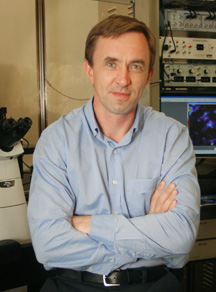

Connecting with the Science of the Synapse
By Jeff Worley
Anton Maximov, an assistant professor at The Scripps Research Institute, didn't set out to be a neuroscientist. His first scientific love was marine biology.
"I was born and grew up in St. Petersburg, Russia, and on vacation my parents would often go to the Black Sea. I was 10 or 11 and became fascinated with the various creatures that lived there—from scorpion fish to stingrays that flew through the water, to the crabs and jellyfish that washed ashore," Maximov recalls. "What made them tick? How did they stay alive?"
These questions perhaps hinted at his eventual path into neuroscience and the road he would take from St. Petersburg University to University of Texas Southwestern Medical Center in Dallas, and then The Scripps Research Institute in La Jolla, California.
At UT Southwestern, Maximov trained in the lab of Thomas Südhof, a molecular neuroscientist who is also a professor and chair in the Department of Neuroscience and a senior investigator with the Howard Hughes Medical Institute. Südhof's research is focused on understanding the molecular mechanisms that control secretion of neurotransmitters in brain, an area that fascinated Maximov.
The human brain contains billions of neurons, each forming up to several thousand synaptic connections, asymmetrical cellular junctions that transmit the signals from one neuron to another.
"Synapses are incredibly complicated and fine-tuned machines that operate with high speed and precision," says Maximov. "One defining property of chemical synapses is their plasticity. Neurons adapt to external stimuli by changing the structural and functional properties of their synapses and these alterations ultimately affect the neural circuitry in the brain as well as overall behavior. In a way, synapses can shift gears to operate at different powers and speeds.
Maximov arrived at Scripps Research at the end of 2007, so he has just finished shifting gears himself. Now happily settled in to the Department of Cell Biology and The Institute of Childhood and Neglected Diseases (ICND) at Scripps Research, he is looking forward to results from jump-starting his research program, taking advantage of new tools that enable his laboratory to monitor neural activity with high resolution.
Interrogating the Synapse
The major goal of Maximov's current research is to understand the mechanisms that regulate adaptive synaptic responses in the brain.
"We now know a great deal about the basic molecular machinery that controls secretion of neurotransmitters," Maximov says. "It has become apparent that, even in the homogeneous populations of neurons, neurotransmitters can be released in different modes. The question that we are currently trying to pursue is how the individual neurons and neural circuitry respond to short- and long-lasting changes in intrinsic properties of transmitter release machinery."
In addition, the lab is continuing to explore new neuronal secretory pathways.
"Apart from the classical neurotransmitters, neurons release several classes of small molecules that mediate a wide range of regulatory effects in synapses," he explains. "Some of these synaptic modulators have been known for decades, yet we still know very little about the cellular and molecular mechanisms controlling their secretion."
Maximov notes that this area of research has significant clinical implications, since deficits in secretion have been associated with a number of cognitive abnormalities in humans.
To address these areas of research, Maximov's lab is using a ultidisciplinary approach. To study synaptic transmission and plasticity, the lab is employing various biochemical genetic and biophysical tools. The group's major experimental approaches combine genetic manipulations using mouse and in vitro models with high-resolution imaging and electrophysiological analyses of neural activity.
Maximov is enthusiastic about another new direction his lab has recently taken—stem cell research.
"A number of neurological and psychiatric disorders have been linked to synaptic abnormalities," he says. "However, until recently, it was unrealistic to directly test these hypotheses by monitoring the events of synaptic transmission in live human neurons. Today, the revolution in stem cell technologies makes it possible to derive neuronal cell lines whose genetic material will be identical to human patients. This is an exciting and fascinating new area. Ultimately, these technologies will be instrumental for understanding how human genetic abnormalities translate into synaptic deficits."
Maximov believes that whatever direction his work takes, he will benefit from the fact that he will be doing this work at Scripps Research. "As a new investigator, it's exciting to be surrounded by so many really talented people including several terrific neuroscientists at the ICND," he says.
The respect Maximov has for his colleagues, past and present, goes both ways.
"Anton was one of the best postdocs I have had—a fantastic young scientist with great ideas who did exceedingly well in my lab and has all it takes to make major contributions in future," says Südhof. "I'm proud to see him on the faculty at Scripps, and look forward to watching him succeed."
Send comments to: mikaono[at]scripps.edu

The major goal of Anton Maximov's current research is to understand the mechanisms that regulate adaptive synaptic responses in the brain.
